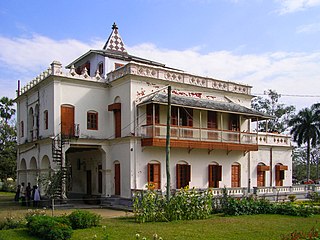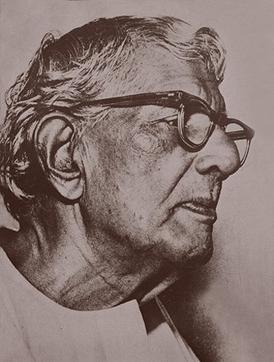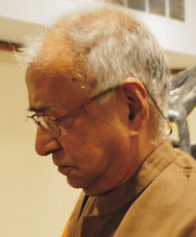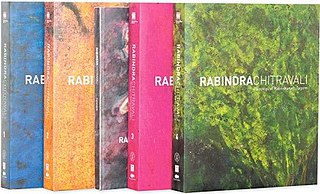
Ratan Parimoo, born in Kashmir, is an art historian, art educator, pedagogue, artist and former director of the Lalbhai Dalpatbhai Museum, Ahmedabad. Ratan Parimoo was one of the founder members of Baroda Group.

The National Gallery of Modern Art (NGMA) is the premier art gallery under Ministry of Culture, Government of India. The main museum at Jaipur House in New Delhi was established on 29 March 1954 by the Government of India, with subsequent branches at Mumbai and Bangalore. Its collection of more than 17,000 works by 2000 plus artists includes artists such as Thomas Daniell, Raja Ravi Verma, Abanindranath Tagore, Rabindranath Tagore, Gaganendranath Tagore, Nandalal Bose, Jamini Roy, Amrita Sher-Gil as well as foreign artists. Some of the oldest works preserved here date back to 1857. With 12,000 square meters of exhibition space, the Delhi branch is one of the world's largest modern art museums.

The works of Rabindranath Tagore consist of poems, novels, short stories, dramas, paintings, drawings, and music that Bengali poet and Brahmo philosopher Rabindranath Tagore created over his lifetime.

Jamini Roy was an Indian painter. He was honoured by the Government of India the award of Padma Bhushan in 1954. He remains one of the most famous pupils of Abanindranath Tagore, another praised Indian artist and instructor. Roy's highly simplified, flattened-out style, and reminiscent of European modern art was influenced by the “bazaar” paintings sold at Indian temples as talismans.

Nandalal Bose was one of the pioneers of modern Indian art and a key figure of Contextual Modernism.
Paresh Maity is an Indian painter. He is a prolific painter in a short career span.

Ramkinkar Baij was an Indian sculptor and painter, one of the pioneers of modern Indian sculpture and a key figure of Contextual Modernism.

Mukul Chandra Dey was one of five children of Purnashashi Devi and Kula Chandra Dey. He was a student of Rabindranath Tagore's Santiniketan and is considered as a pioneer of drypoint-etching in India. The entire family of Mukul Dey had artistic talents, the brother Manishi Dey was a well-known painter, and his two sisters, Annapura and Rani Chanda, were accomplished in arts and crafts as well.
Sankho Chaudhuri was an Indian sculptor, and a noted figure in the art scene of India. (Although named Naranarain in due family tradition, he was more widely known by his pet name Sankho). Ram Kinker Baij was his teacher. He began close to cubism and then was influenced by István Beöthy, whom he had met in Paris. His themes have included the female figure and wildlife. He has worked in a wide range of media and produced large-scale reliefs and mobiles.

Kalpathi Ganpathi "K.G." Subramanyan was an Indian artist. He was awarded the Padma Vibhushan in 2012.
T. V. Santhosh is an Indian artist based in Mumbai. He obtained his graduate degree in painting from Santiniketan and master's degree in Sculpture from M.S. University, Baroda. Santhosh has acquired a major presence in the Indian and International art scene over the last decade with several successful shows with international galleries and museums. His earlier works tackle global issues of war and terrorism and its representation and manipulation by politics and the media. Santhosh's sculptural installation "Houndingdown" was exhibited in Frank Cohen collection ‘Passage to India’. Some of his prominent museum shows are ‘Aftershock’ at Sainsbury Centre, Contemporary Art Norwich, England in 2007 and ’Continuity and Transformation’ show promoted by Provincia di Milano, Italy. He lives and works in Mumbai.

The modern Indian art movement in Indian painting is considered to have begun in Calcutta in the late nineteenth century. The old traditions of painting had more or less died out in Bengal and new schools of art were started by the British. Initially, protagonists of Indian art such as Raja Ravi Varma drew on Western traditions and techniques including oil paint and easel painting. A reaction to the Western influence led to a revival in primitivism, called as the Bengal school of art, which drew from the rich cultural heritage of India. It was succeeded by the Santiniketan school, led by Rabindranath Tagore's harking back to idyllic rural folk and rural life. Despite its country-wide influence in the early years, the importance of the school declined by the 'forties' and now it is as good as dead.

Raman Siva Kumar, known as R. Siva Kumar, is an Indian contemporary art historian, art critic, and curator. His major research has been in the area of early Indian modernism with special focus on the Santiniketan School. He has written several important books, lectured widely on modern Indian art and contributed articles to prestigious international projects such as the Art Journal, Grove Art Online or The Dictionary of Art, Oxford University Press.

Rabindra Chitravali is a 2011 four-volume set of books by art historian R. Siva Kumar that contains paintings of Rabindranth Tagore. These include about 1700 paintings in the Rabindra Bhavana and Kala Bhavana collections of Visva-Bharati, Santiniketan; and more than 300 paintings in the collection of the National Gallery of Modern Art and the collections at Rabindra Bharati University, Kolkata; National Gallery of Modern Art, New Delhi and Bangalore; and Indian Museum, Kolkata.

National Gallery of Modern Art is an art gallery in Bangalore. It was inaugurated in the year 2009. It showcases modern Indian art and houses paintings by Raja Ravi Verma, Jamini Roy, Amrita Sher-Gil, Rabindranath Tagore and a large number of modern and contemporary artists. Equipped with an auditorium, a public art reference library, a cafeteria, and a museum shop cum facilitation block, the NGMA Bengaluru looks ahead to becoming a hub of art activities and a major cultural centre at Bengaluru. The gallery organizes and hosts talks on art and culture by speakers, seminars, film screenings as well as workshops and guided walks throughout the year.

Kala Bhavana is the fine arts faculty of Visva-Bharati University, in Shantiniketan, India. It is an institution of education and research in visual arts, founded in 1919, it was established by Nobel laureate Rabindranath Tagore.

The Last Harvest: Paintings of Rabindranath Tagore is a book on Rabindranath Tagore (1861–1941) and his paintings edited by R. Siva Kumar. In 2011 it was produced in conjunction with the traveling exhibition The Last Harvest: Paintings of Rabindranath Tagore.
Santiniketan: The Making of a Contextual Modernism was an exhibition curated by R. Siva Kumar at the National Gallery of Modern Art in 1997, on the occasion of the 50th anniversary of India's Independence.
The following is a list of notable people associated withVisva- Bharati University and/or Santiniketan, a neighbourhood in Bolpur city in West Bengal, India:

Bireswar Sen (1897–1974) was an Indian painter, writer, and teacher, who was influenced by the Bengal School of Art and Western modernism, but then later developed a unique visual language of miniatures. He depicted grand landscapes, mostly featuring the Himalayas, on paintings measuring smaller than postcards. Sen was popular and celebrated during his lifetime, but faded from public consciousness after his death.






















